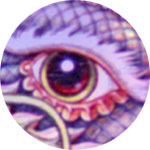Two Art Exhibits Show The Hip-Hop, Kung Fu Connection
BY STAFF IN ARTS & ENTERTAINMENT ON APR 12, 2017 2:30 PM

MC Yan and Fab 5 Freddy (Courtesy of the Sackler)
By DCist contributor Elena Goukassian
What do hip-hop and kung fu have in common? That question may be answered by two new exhibitions at the Sackler and Hyphen DC, a new gallery in Ivy City. Both shows focus on the paintings of Fab 5 Freddy and MC Yan, two figures largely known for their work in music and graffiti.
New York’s Fab 5 Freddy (Fred Brathwaite) was a pioneer of hip-hop culture in the late 1970s. He was friends with people like Jean-Michel Basquiat, Keith Haring, and Lee Quiñones, and was name-checked in Blondie’s 1980 hit “Rapture.” It was Freddy who famously painted the giant Campbell’s soup cans (an homage to Andy Warhol) on a subway car. He was also the original host of “Yo! MTV Raps,” the first hip-hop music show on MTV, but he may be best known as the man behind the 1983 film, Wild Style, the first ever “hip-hop movie,” which showed the music, graffiti, dancing, and general culture of early New York hip-hop.
On the other side of the word, Hong Kong’s MC Yan (Chenguang Ren)—just a kid when Freddy was at his height—was first exposed to graffiti and hip-hop culture while at art school in France, and he was immediately hooked. Back home, he joined the influential Cantonese hip-hop group, LMF. These days, Yan plays music, makes art, and designs for brands like Nike. According to Hyphen DC’s bio, Yan may even have tagged the Great Wall of China and government buildings in Hong Kong.
Freddy and Yan first met through a mutual friend in 2012. After several Skype conversations, they realized just how much each had been influenced by the culture of the other—Freddy by kung fu movies in the ’70s and Yan by American hip-hop several years later. They both zoomed in on Bruce Lee as the epitome of that influence.
“I used to watch a lot of kung fu movies and realized what Bruce Lee really meant and what influence he had on the American urban culture,” Freddy told Hypebeast in a 2012 interview. “You could detect his influence in movies and music. Just take James Brown’s lyrics in ‘The Payback’: ‘I don’t know karate, but I know ka-razy’ or ‘Kung Fu Fighting.’ Kung fu’s influence went all the way up to the hip-hop culture. Fu-Schnickens and Wu-Tang Clan had a kung fu vibe early on in their careers.”
Meanwhile in Hong Kong, Yan noted that Bruce Lee was still a rather controversial figure, largely because of his politics and personal life.
The exhibit Kung Fu Wildstyle includes five paintings by each artist, and touring the world since 2012, Freddy and Yan incorporated aspects of each other’s cultures into works that can easily be read as unconventional portraits of Bruce Lee.
Freddy’s paintings almost exclusively use one of the most famous photos of Lee from Enter the Dragon—where he’s grimacing and flexing in preparation for a fight, with three red scratch marks on his chest. The bloody marks in Freddy’s paintings are bedazzled with rhinestones, with Lee (or multiple Lees) floating over a background collage of boomboxes, tags, and the now-defunct RR and RJ subway trains. In one painting, Freddy’s rhinestoned self-portrait appears in the middle of the canvas, flanked by a Bruce Lee in each corner.

MC Yan, Shaolin #3 (detail) Courtesy of Hyphen DC
Yan’s paintings go even further with the collage idea. Made up of small, square canvases, they’re assembled together tightly and slightly overlapping, kind of like the dense rooftops of Hong Kong. Painted on the canvas collage are sponge-paint-like images of Bruce Lee’s signature moves, but if you look closer, you’ll also see drawn outlines of traditional Chinese architecture.
Back in Ivy City, the two artists show off their most recent works. Freddy uses the same style of popping paintings off the wall with rhinestones for portraits of famous African Americans like Huey Newton, Jack Johnson (the boxer, not the singer), Bumpy Johnson (the Prohibition-era Harlem mob boss), and martial artist Jim Kelly, who co-starred with Bruce Lee in Enter the Dragon.
Yan has also largely stuck with the same style, although his rooftops at Hyphen are much more pointed, with a focus on the drawings of traditional Chinese architecture, and added surveillance cameras popping up in random places. It creates the illusion of jumping from roof to roof, always under the watchful eye of the Chinese government. As an added bonus, Yan tagged one of the gallery walls at the opening party with similar rooftops rounding the corner—although, apparently he only did it because his paintings got stuck in customs and were unable to make it in time for the gallery opening.
So what do hip-hop culture and kung fu have in common? As Fab 5 Freddy told the Film Society of Lincoln Center in 2012: “They share a rebellious nature—a flamboyant way of expression.”
Kung Fu Wildstyle runs through April 30 (daily, 10 am-5:30 pm) at the Arthur M. Sackler Gallery, 1050 Independence Ave. SW.
Fab 5 Freddy & MC Yan: New Work 2017 runs through April 29 (Thursday-Saturday, 1-6 p.m,) at Hyphen DC, 1402 Okie St. NE.








 Reply With Quote
Reply With Quote












